 |
| Museo ni Baldomero Aguinaldo in Kawit, Cavite |
“May iba pa palang Aguinaldo?” asked Bryan, a friend of mine who was surprised upon learning that an Aguinaldo, whose first name was not Emilio, exists in the country’s written history. “Yes Sir, pinsan s’ya ni Emilio Aguinaldo, hindi lang siya ganun kakilala tulad ni Emilio na naging presidente natin,” the shrine staff eagerly replied.
Baldomero Aguinaldo was not among the most talked about historical figures not because of the lack of significant contribution, but only because of being overshadowed by the prominence of Gen. Emilio Aguinaldo—his same aged first cousin, fellow Caviteño, and contemporary in the wars against the Spaniards and the Americans. He was not as recognized as Jose Rizal and Andres Bonifacio, who had their birthdates and death anniversaries observed as public holidays throughout the country. He was unlike Apolinario Mabini and Marcelo del Pilar who had their portraits immortalized in our coins and banknotes, or Melchora Aquino, Gabriela Silang and Juan Luna who were staples of our History subjects.
Aguinaldo belongs to the hundreds of lesser known heroes who had also helped propel the cause of our freedom and nationhood. His ancestral home in Kawit, Cavite became a shrine dedicated in his honor for a reason.
Baldomero Aguinaldo, a Revolutionist Life
Baldomero Aguinaldo y Baloy, known to many as Capitan Berong, was born on February 27, 1869; fourth among the nine children of well-off local entrepreneurs Cipriano Aguinaldo and Silveria Baloy of Cavite el Viejo (now Kawit). His father was the brother of Don Carlos Aguinaldo, Gen. Emilio Aguinaldo’s father who was once Cavite el Viejo’s gobernadorcillo (present-day municipal mayor).
More often than not, cousins that are of the same age have a very close relationship. That was true with Miong (Emilio’s nickname) and Berong who were born just shy of a month apart—Miong was born on March 22.
READ ALSO: Inside Emilio Aguinaldo's Mansion
 |
| Baldomero Aguinaldo's bust |
Berong was a stalwart of his cousin. They were both generals of the Filipino forces during the 1896 revolution, working closely together over the course of the hostile era and thereafter.
Berong also held several cabinet positions during Emilio Aguinaldo’s presidency. But all these appointments were not because of their closeness, but for Berong’s heroic mettle and legal knowledge that were valuable to the revolutionary movement and to the subsequent governments that Miong had took the helm of. Before the war broke out in August 1896, Berong had already held different government posts: Directorcillo (Secretary to the Gobernadorcillo), Registrador de Titulos (Registrar of Deeds), an eminent position considering the value of land during that time, and Juez de Paz (Justice of Peace) where he held specific judicial powers within his jurisdiction.
Berong started his early education in his Kawit hometown. He transferred for his segunda enseñanza (secondary education) at Colegio de San Roque, a private school owned by lawyer and educator Jose Basa y Enriquez, who was known in local Cavite history as “the Teacher of Teachers.” When he moved to Manila, he attended the Ateneo Municipal and earned Bachiller en Artes, his bachelor’s degree. He then transferred to the Universidad de Santo Tomas to attend law school. However, he dropped out before obtaining a law degree due to the onset of the Philippine Revolution, when he and Emilio joined the Katipunan.
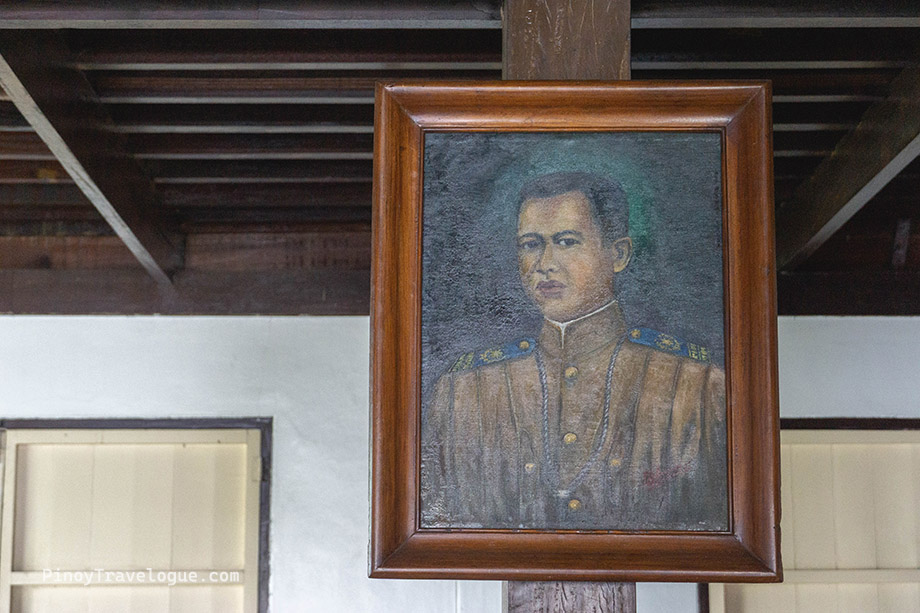 |
| A portrait of Gen. Baldomero Aguinaldo |
In June 1895, the Aguinaldo cousins, together with brothers Candido and Daniel Tirona, established the Magdalo council—they named it after Kawit’s town patroness St. Mary Magdalene—a faction of the Katipunan chapter in Cavite known for its rivalry with the other faction called Magdiwang. Though Emilio, who used “Magdalo” as his code name, was widely known as the council’s leader, Berong officially led the council as its president.
In April 1897, following his election in absentia as president of the revolutionary government during the controversial Tejeros Convention, Emilio Aguinaldo presided over what is known today as the Naic Assembly, where Berong was appointed as Director of Finance. The following month, he served as Auditor de Guerra (Judge Advocate General) during the court martial of Andres Bonifacio and his brother Procopio.
Berong was Secretary of Treasury and one of the drafters of the constitution of the short-lived Republic of Biak-na-Bato that was established in November 1897. He was Minister of War and Public Works during the Revolutionary Government of 1898 and the succeeding First Philippine Republic that was established via the Malolos Constitution in January 1899.
Berong’s appointment as head of Finance recognized him as the very first secretary of the present-day Department of Finance (DOF), while being head of War and Public Works made him the first secretary of the Department of Public Works and Highways (DPWH) as well as one of the earliest National Defense (DND) secretaries.
 |
| A diorama depicting the Battle of Binakayan |
Capitan Berong was not just all brains. He actively fought in command in numerous battles including the simultaneous attacks on the shores of Binakayan in Cavite el Viejo and Dalahican and Dagatan in Noveleta on November 9-11, 1896. The three-day bloody skirmish, known today as the Battle of Binakayan, led to the first significant victory of Filipino forces during the Philippine Revolution.
He also saw action in the Battles of Zapote, of Salitran, and of Alapan—the battle which led to Emilio Aguinaldo’s historic unfurling of the Philippine flag and declaration of independence from Spain in 1898. During the Filipino-American War (1899-1901), Emilio sent Berong to command the revolutionary forces in the provinces of Southern Luzon.
Gen. Baldomero Aguinaldo retired to private life when the war ended in 1901. He spent his time tending a coconut plantation that he acquired in Silang, Cavite earlier in his life. In 1912, Emilio Aguinaldo created Asociación de los Veteranos de la Revolución (Association of Veterans of the Revolution), an organization that secured pension and land ownership to its members that comprised former soldiers and servicemen of the Philippine Revolution and Filipino-American War. Berong served as the association's president from its inception until he succumbed to heart failure and rheumatism on February 4, 1915, three weeks before he turns 46.
 |
| Baldomero Aguinaldo's tomb at the backyard of the museum |
His wake lasted for a little over two weeks. Among those who paid respect, according to the book of condolences during the wake, were Emilio Aguinaldo, Felipe Agoncillo, Mariano Ponce, and Gregorio Aglipay. A great crowd gathered for his funeral at the Manila North Cemetery on February 21.
Berong was survived by his wife Petrona Reyes and their two children: Leonor and Aureliano. Leonor was the mother of Cesar E.A. Virata, who served concurrently during the later years of Marcos Sr. presidency as the country’s Prime Minister and Finance Secretary—like his lolo Berong. UP Diliman’s school of business was named after Virata.
Museo ni Baldomero Aguinaldo
Along the narrow two-way avenue of Bisita Street, a few kilometers from Kawit-Imus boundary, stands a two-story period house—a bahay na bato—painted in sky-blue and white. It was enclosed within its modest lot by thick adobe walls and a white picket fence. Quite a number of hoisted Philippine flags surround the property.
Berong built the house in 1906 where he lived with his family and spent his remaining years cultivating the property’s spacious backyard. In 1982, Berong’s grandchildren, headed by then Prime Minister Cesar Virata, donated the house to the government. By then, some of its parts had already collapsed since it had not been inhabited for some time.
READ ALSO: Doña Aurora Quezon's House in Baler
The Intramuros Administration restored the house and has been managed since then by the National Historical Commission of the Philippines (NHCP) as Museo ni Baldomero Aguinaldo, exhibiting Berong’s legacy and their family’s memorabilia. Visiting the shrine is free to the public.
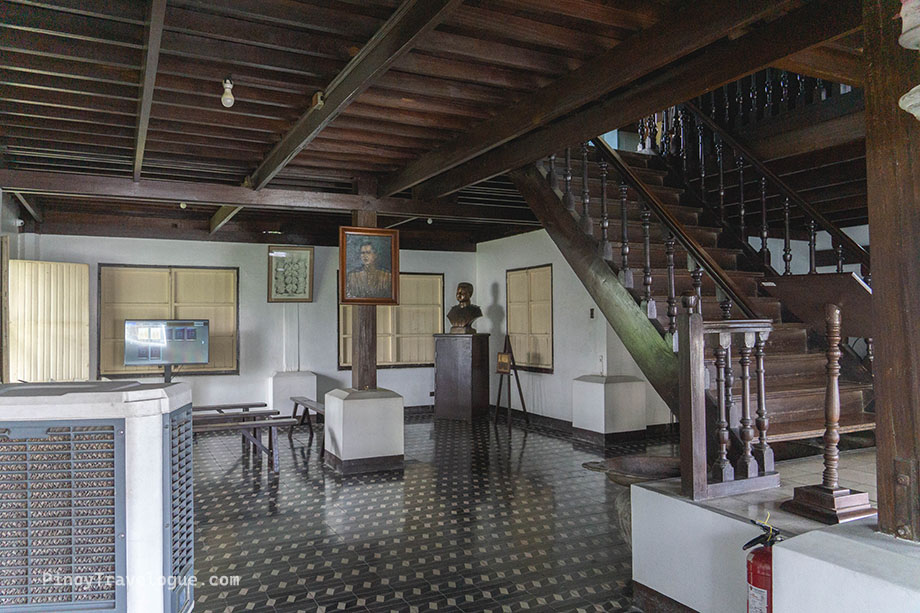 |
| Museum's ground floor |
The house tour starts at the zaguan—the open space at the ground floor that functioned as parking space for carriages and carrozas or storage space for farming supplies and produce—with an audio-visual presentation on Berong’s life and the house’s history.
The ground floor, whose walls were made of adobe, now holds some of Berong’s memorabilia, a history exhibit, and a display of several farming and fishing equipment. A flight of stairs, made of narra and molave, leads up to the living quarters.
The second floor, whose walls were also of the best Philippine hardwood, holds the sala (living room), which occupies the portion of the street front, the two bedrooms (the master and the children’s), the comedor (dining room) and the kitchen.
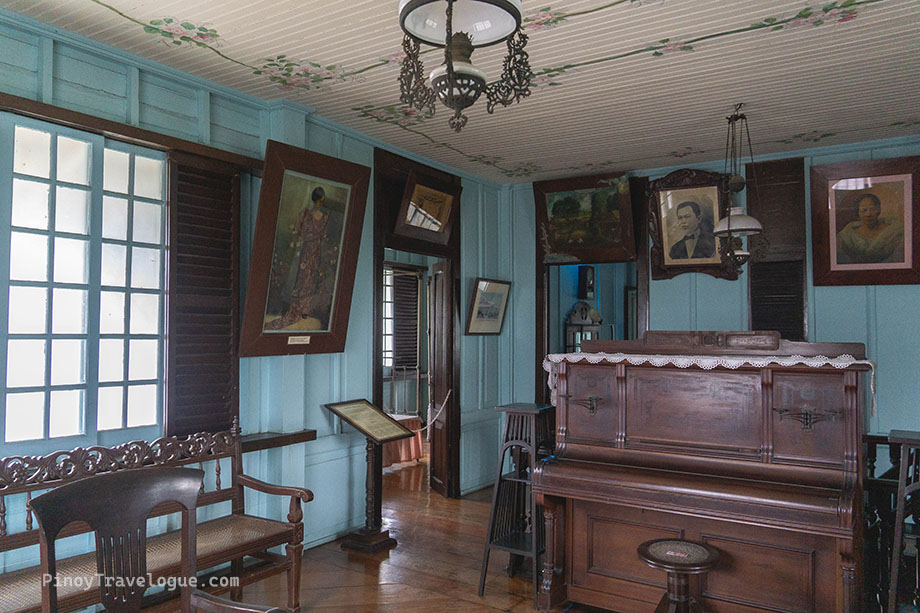 |
| Sala (living room) |
One can imagine, at the sala, the Aguinaldo family while holding social gatherings with their friends—clad in period dresses, sipping refreshments while chatting, perhaps about life, politics and business—or the family while enjoying the passing of religious processions or secular town parades from the wide-designed windows. These high and wide windows, together with the ventanillas (small window located right under the windowsill), provides opening from floor to ceiling, thereby making the house well-ventilated.
The distinctive item at the sala is an heirloom Rachals-brand upright piano with the inscription “Successos Campana Representante en Filipinas” on it.
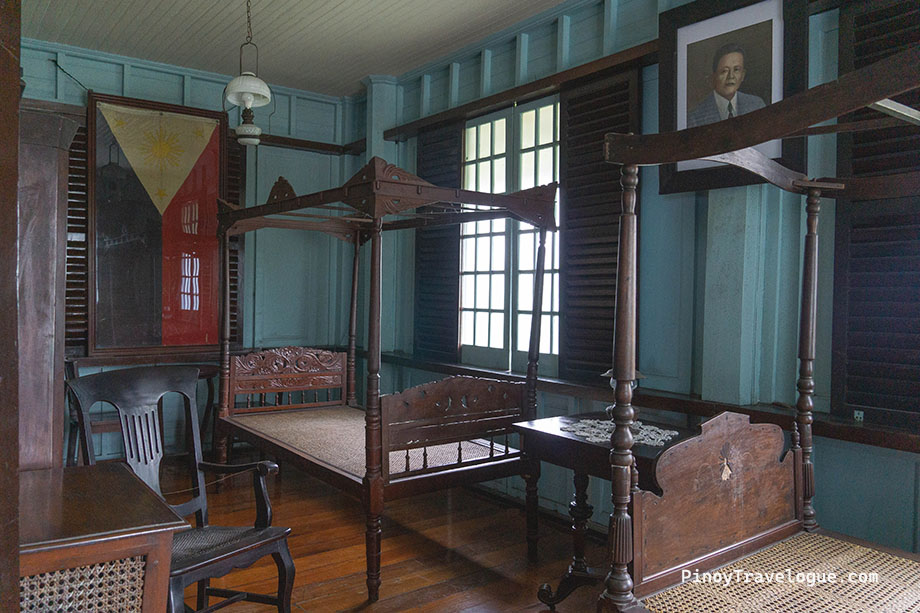 |
| Aguinaldo children's bedroom |
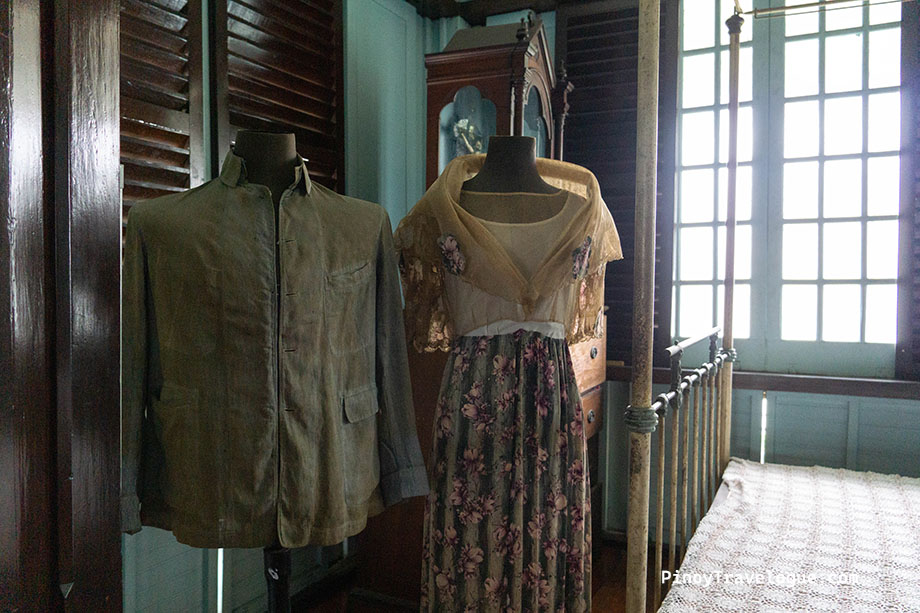 |
| Gen. Aguinaldo's rayadillo displayed in the master bedroom |
Bedrooms are furnished with bedsteads from the 1930s. Though off-limits to visitors, the bedroom doors are left open. On display inside the master bedroom are a good number of antique furniture and two mannequins standing side-by-side wearing Berong’s tarnished rayadillo (blue-and-white striped military uniform) and a Filipiniana dress apparently of his wife.
The comedor has a glass-fronted vajillera (china cabinet), a platera (cabinet for silverwares) and a stuffed deer’s head hung on the wall. The newest attraction and attention-grabbing item exhibited at the comedor is the diorama that depicts the storied Battle of Binakayan—the encounter between Spanish and Filipino forces that Berong was most remembered for. Berong’s grandchildren, according to the shrine staff, donated the intricate diorama to the museum just months prior to our visit.
 |
| Kitchen |
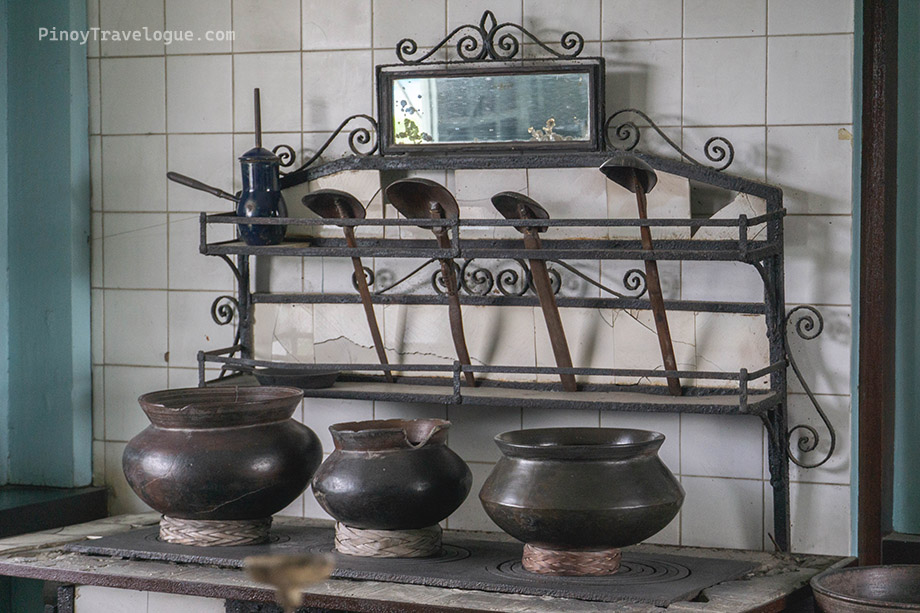 |
| Old utensils displayed at the kitchen |
The kitchen floor is of bamboo slats, thus airier than other parts of the house. It has a shabby, 16-foot high metal ice box with two compartments, an iron cooktop with clay pots, and a wooden table that has a seating for ten. Built outside the comedor and kitchen windows is the bangguera, an extension of the windowsill made of slats, where newly washed plates were racked between the slats and wet glasses were upended on the slatted sides to air-dry before they were kept in the cabinets.
The toilet and bath are off the porch at the rear leading down to the backyard where the general and his family were interred. Years after his death, Berong’s remains were exhumed at the Manila North Cemetery and were transferred to his Kawit home.
 |
| The house's rear leading to the backyard |
Even in death, Berong and Miong are much alike. They both died in February, though Miong outlived his cousin for more than Berong’s age at death (Emilio died in 1964). They were both buried in their backyard and their homes are now shrines dedicated in their honor—two Aguinaldo Shrines, only about two and a half kilometers far from each other, that everyone can visit in Kawit, Cavite.
Our history textbooks are filled with biographies of our valiant national heroes, but sometimes, a visit to their extant houses, shrines and museums, especially that of the lesser known heroes like Gen. Baldomero Aguinaldo, gives us a whole different perspective. There, we get a glimpse of how they lived extraordinary lives during the extraordinary times of war. There, we get to understand how they gained the acclamation that immortalizes them. There, as the cliché goes, we get to see written history come to life.
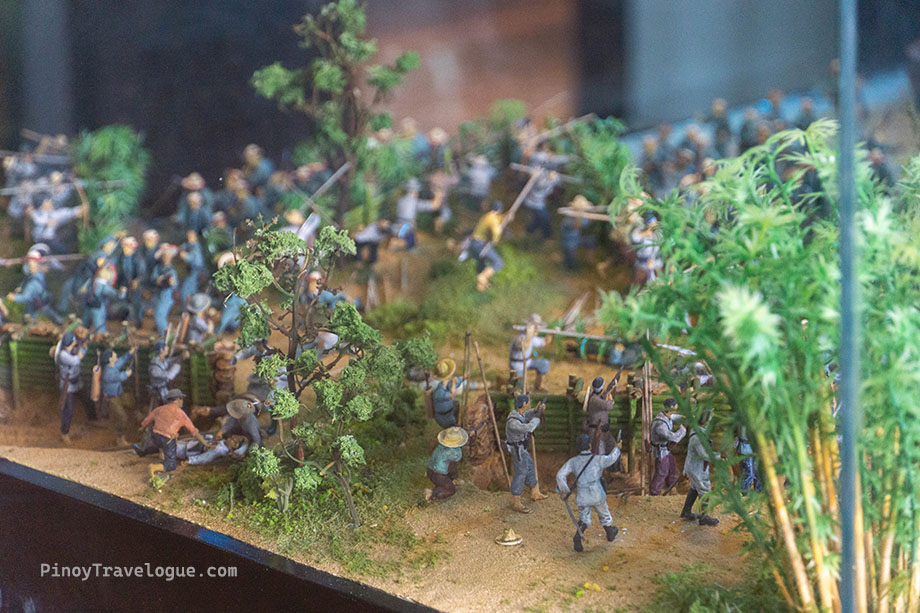 |
| Battle of Binakayan diorama |
How to Get to Baldomero Aguinaldo Shrine
Address: Bisita St., Brgy. Balsahan-Bisita, Kawit, Cavite
Opening Hours: Tuesday-Sunday / 8:00 AM - 4:00 PM
Entrance Fee: FREE
Contact: (046) 7434 5983 / mba@nhcp.gov.ph / NHCP Museo ni Baldomero Aguinaldo (Facebook page)
Drive: You can take the Manila-Cavite Expressway (CAVITEx). https://maps.app.goo.gl/So4wBrWordusrjBo7 (via Google Maps)
Commute: From Manila, go to the Paranaque Integrated Terminal Exchange (PITX) and take a bus bound for Kawit. Take a tricycle to bring you to 711 store in Binakayan. The shrine is walking distance from there.
This article was originally published in the July 2022 issue of Enrich magazine (with some minor revisions).


